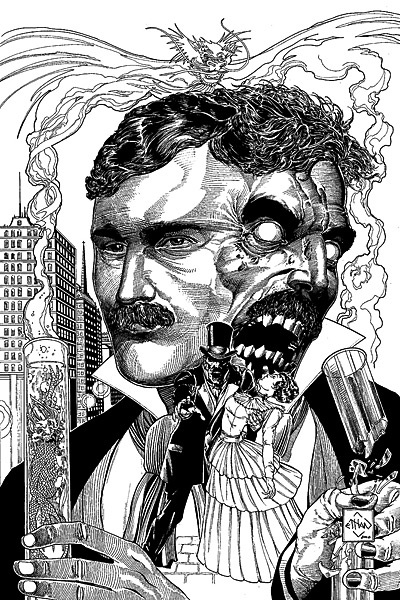Welcome to Wednesday Comics Pull-List, here on Tor.com! Every week we post reviews of a select handful of this week’s comic releases. From those reviews, we let you know what we would pull for keeps.
This week’s batch includes:
- Bruce Wayne – The Road Home: Batgirl
- Edge of Doom #1
- Emily the Strange #1 (of 4)
- Pilot Season: Forever #1
- John Constantine: Hellblazer – City of Demons #1 (of 5)
- Knight and Squire #1
- Spike #1 (of 8)
- Star Trek – Khan: Ruling in Hell #1 (of 4)
- Strange Tales II #1 (of 3)
- Superior #1
- Tomb of Terror #1
- Victorian Undead Special
Each reviewer snagged a shining moment of comics this week, two of them coming as anthologies. There was a stark absence of Watson gnawing on Holmes, though.
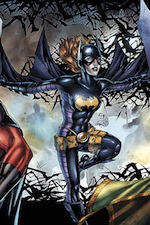 Bruce Wayne – The Road Home: Batgirl
Bruce Wayne – The Road Home: Batgirl
Written by Bryan Q. Miller
Art by Pere Perez, Shane Davis
(DC Comics)
Pull: Yes. This is a perfect jumping-on point for new readers, while addressing some concerns that older readers.
Chris says: Batman is back, and this month DC is releasing a series of one-shots to portray the reactions to that return along the many varied characters of the Bat franchise. (Also to soft-start ongoing titles for many of these characters.) In the case of Bruce Wayne: The Road Home – Batgirl the venture has resulted in a great comic.
Batgirl, in this instance, is played by Stephanie Brown, a character who’s controversy precedes her. That controversy has mostly played itself out, either by being directly addressed by DC or by having the character revived and subsequently distanced from her ignoble (to put it mildly) end. I don’t mean to put across that everything is now okay, but when Bruce Wayne mentions in this issue that Batgirl “deserves a second chance,” you wonder if that’s not just meant for the character.
DC seems intent on re-establishing Stephanie Brown as an icon in the Batman family and this one-shot does a tremendous job of providing a jumping-on point for new readers. For old readers, her history with Batman and the Birds of Prey is addressed in the story without being intimidating to new readers. This is the first time I’ve ever read this character, and she reminded me quite a bit of Spider-Man. Lots of guilt, anxiety over self-worth, quipping, and daring fights. If anything, Batgirl is overly quippy, but in a way that obviously stems from her character’s nervousness and not the writer’s. The pace is energetic and light here and the character humor in the book owes a great deal to artist Pere Perez’s expressive comic touch.
 Edge of Doom #1
Edge of Doom #1
Written by Steve Niles
Art by Kelley Jones
(IDW)
Pull: No. If you’re that hard-up for horror comics, then maybe it’s time to start writing your own.
Matt says: Over the years, Steve Niles has come to be a trusted name in horror comics. In the first issue of Edge of Doom, he’s teamed with Kelley Jones: an artist already well-known for his moody, horror-influenced art (see Jones’s arcs in the Sandman series, and especially his various Batman work). Furthermore, it’s not the duo’s first collaboration (see Batman: Gothman After Midnight). Suffice it to say, then, I was expecting good things from Edge of Doom. Alas, I was in for a disappointment.
Niles and Kelley both take a few pages to warm up. Niles horrendously overwrites the first four pages or so, which are told in long, prose-style caption boxes; you could take away all of the artwork and not miss any story. Meanwhile, Kelley can’t seem to decide how the character’s going to look; is he 190 pounds, or 260? Is his hair short, or getting long, receding or full and thick? The art is kept a little more consistent thanks to the simple color scheme (and Jay Fotos’s simple, understated coloring is probably the best part of this issue), and readable thanks to the fact that it’s essentially just window-dressing for Niles’s captions.
By the time Niles lets the pictures do the talking, we’re already five or six pages into what ends up being a really simple story. An incident with little demons in the backyard happens, and then the story seems to just…end. The issue ends with an enigmatic “End?” caption, but whether or not Niles and company carry the story on, there seems to be little point—the horror doesn’t serve to carry any social commentary, pathos, or psychological analysis. It carries none of The Twilight Zone’s poetic justice or flair for tragic irony, nor even any of Stephen King’s talent for exploiting the stuff that scares you. This is simply a story about a depressed drunk running into demons in his backyard. If this is enough to scare—let alone horrify—you, then I’ve got some Archie comics that will blow your mind.
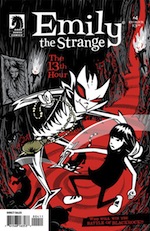 Emily the Strange #1 (of 4)
Emily the Strange #1 (of 4)
Written by Rob Reger
Art by Buzz Parker
(Dark Horse)
Pull: Yes. Get it for your kids and/or get it to remind yourself of when you were a kid.
Chris says: I’m usually a little let down by black-and-white comics. No matter how good they look, it seems like they’d always look just a little better in color. Emily the Strange is an exception to that. Buzz Parker’s black, grey, and white art practically sparkles with life, enveloping your senses. Color (save for a splash here and there_ would only ruin it.
Emily the Strange: The 13th Hour #4 is a satisfying conclusion to this current mini-series, telling a tale of love and acceptance in a heavily gothic setting and giving Emily a boisterously creative agency one usually expects from cheerier-looking tales. The setting may be gothic, but there is no moping and no narcissism present. It’s very pleasing to read something so encouraging and to know that there’s an empowering alternative out there for parents who want to expose their children to different flavors of storytelling.
Also, Emily’s Rube Goldberg-esque solution to her problems is amazing.
 Pilot Season: Forever #1
Pilot Season: Forever #1
Written by Brad Ingelsby
Art by Thomas Nachlik, Bagus Hutomo
(Top Cow)
Pull: Meh. Like most “Pilot Season” books, it’s probably better to wait and see if this one survives long enough to catch as a trade paperback.
Matt says: I will admit that I’m a little confused by Top Cow’s recent trend of “comic creators” who don’t seem to actually help make the comics. Forever was “created by” Matt Hawkins, who tells us in a little note at the end of the book that his “college degree was in Physics,” and that his goal is to “inject some real science into some of these fictional tales.” That said, he’s not the writer—and indeed Hawkins writes that the book changed a lot when Brad Inglesby “came on board to develop the project and write the book”—nor is he the artist (a chore handled by Thomas Nachlik, who I cannot help but see as a very poor man’s Alex Maleev). At any rate, all confusion aside, it’s not clear that Hawkins’s original goal is being met in Forever at all: the basic premise seems to be that a pharmaceutical company is artificially extending certain people’s lives by “stealing” life from others. As a metaphor for capitalism, it’s really nice. But as “hard” science? Utter nonsense, of course.
That said, it’s a little hard to tell just yet when and if any hard science is going to crop up. The first issue of Forever seems really concerned with setting up a mystery, and hoping that you’ll come along for the ride out of curiosity. The issue drops a half-dozen little plot set-ups across its 22 pages, providing ample fodder for several (probably ultimately connected) plotlines should the series continue. The main character, however, is largely devoid of personality—we have to be shown that girls are interested in him, because we do not find him interesting; we have to be told that he’s sick of having too many unanswered questions, because we never see him actually fret about unanswered questions; etc.—and so the story never seems to get me to care about the mysteries it’s laying out.
I’ve said before—as I’ll say again—that first issues are tricky. You’ve got to set up material you can use in the future; but it can’t all be planning for the future. You’ve also got to give us something to care about right now, so that we bother coming back. Forever seems to be big on promises for the future, but somewhat light on payoff in the present. Like so many of Top Cow’s “Pilot Season” titles, it reads a bit too much like a rushed, under-polished movie pitch, rather than like a new comic title I want to get excited about.
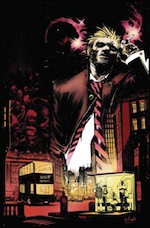 John Constantine: Hellblazer – City of Demons #1 (of 5)
John Constantine: Hellblazer – City of Demons #1 (of 5)
Written by Si Spencer
Art by Sean Murphy
(DC Comics / Vertigo)
Pull: Yes. If you like your supernatural tales served up with a side of British cynic, then this week you’re in luck.
Matt says: Ever since Sean Murphy’s two-issue run on Hellblazer a few years back (“Newcastle Calling”), I’ve been waiting for him to return to the character—Murphy’s combination of slick storytelling and moody, atmospheric ink-work is perfect for the metaphysical, aging punk John Constantine and his gritty, British setting. Here, Murphy’s teamed with Si “Vinal Underground” Spencer, the latest in a long line of Vertigo British-import writers. The combination is fantastic. Spencer nails the dialogue throughout the issue—playing equally well with the slang mélange of street punks and the technical jargon of a hospital ER—all while managing to serve up a first issue that both functions as a complete, satisfying story and sets up a plot-line for the rest of the miniseries. Meanwhile, Murphy flexes the muscles he’s been developing over on Joe the Barbarian, delivering pages that are both rich in detail and yet pared down with a cartoonist’s eye for visual communication.
Both Spencer and Murphy are well-suited to both the Hellblazer title and the John Constantine character; and in fact, if there’s a weakness here, it’s only that City of Demons isn’t going to do anything to change anybody’s mind about either. If you’re a fan of Constantine, this issue’s going to be a welcome addition to the canon. If you’ve never liked the character, however, don’t expect City of Demons to try and convince you otherwise. If anything, the first issue’s a bit understated; some supernatural elements, but nothing terribly trippy or occult just yet. It’s not going to bore you—but I’m certainly looking forward to having some shit hit the fan later on in the series!
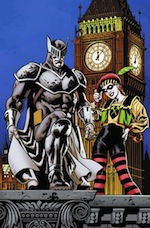 Knight and Squire #1
Knight and Squire #1
Written by Paul Cornell
Art by Jimmy Broxton
(DC Comics)
Pull: Yes for British humor fans.
Gosh, this is British. Mind that going in; although even an Ugly American will probably get a chuckle out of Squire’s line early on that, “I went to lots of different schools. It was either get superpowers that cross class barriers or die.” (Writer Paul Cornell also provides a handy guide for Non-Brits in the back of the book.)
Squire and Knight #1 takes place in a pub called “The Time in a Bottle,” a place which magically prevents heroes and villains from fighting each other so each can have a neutral ground to drink and “discuss diplomacy.” (There is a typical example of this about halfway through, when Squire relates that the pub is where the Martians came to sign a treaty stating that they’ll stop trying to invade Britain and maybe try and invade other places for once.) The book is very dry, very bent on staying humorous, so when things start going wrong the story…stays dry and humorous.
But that’s a good thing, I swear. If the comic had become suddenly serious, it would have felt cheap and unearned. As it is, the story follows the same guidelines that it touts (and which the pub represents): power in moderation. The “moral” of the story, as it were, feels very British in itself, and all of a sudden Cornell isn’t just writing for the laughs, he’s pulled off the marvelous trick of giving his story weight and meaning without changing tone.
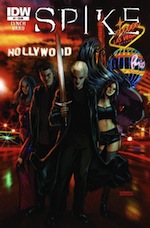 Spike #1 (of 8)
Spike #1 (of 8)
Written by Brian Lynch
Art by Franco Urru
(IDW)
Pull: To each their own but I say no.
Annie says: Admittedly, I am not that into Buffy the Vampire Slayer. I’ve seen the movie, occasionally watched the TV show when it was on but have avoided reading the comics until this morning. I’m all for campy, satirical comics and more times than not I think they’re better than comics that aren’t. This is not the case with Spike #1, though.
The problem I’m having with this comic is that it’s all within the same vein as things like Not Another Teen Movie and, most recently and certainly most applicably, Vampires Suck. The first 10-12 pages of this comic are the history of Spike, which proved to be helpful to a novice like me, but mixed heavily in with those 10-12 pages (and then some) were sardonic remarks about the current craze over vampirism. Twilight is referred to as Twinkle, Team Jacob and Edward are now Team William and Jared. They reference current events, like the time someone attending a showing of Twilight found themselves bitten by a wannabe vampire. I wouldn’t have had a problem with how heavily inundated this comic was with social commentary if the absurdity had at least stopped there, but the story itself made almost no sense to me.
Spike needs to assemble a team to take down “bad vampires” and within that team is a gigantic floating fish. Maybe I don’t know enough about Spike as an individual character but it doesn’t make any sense to me as to why having a gigantic fish with you would prove to be helpful. Furthermore, towards the end of the comic, when Spike is entangled in conflict, no one from his team helps him fight off the gigantic pile of Elvis impersonators that have morphed into some vague version of a Transformer. And then there are the zany one-liners that Spike throws out every other panel. From my perspective, Brian Lynch might have been trying just a little too hard to get this series in while the vampire craze was still piqued. But it’s not over yet and won’t be for a while. (Regardless of the fact that some of us might be ready for it to quietly sink into the same abyss that claimed Pogs and Tamagotchis.)
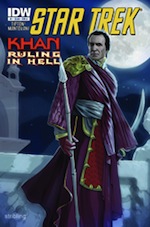 Star Trek – Khan: Ruling in Hell #1 (of 4)
Star Trek – Khan: Ruling in Hell #1 (of 4)
Written by Scott Tipton
Art by Fabio Mantovani, Joe Corroney
(IDW)
Pull: No.
This miniseries aims to explore the time Khan spent exiled on Ceti Alpha V, pre-Wrath of Khan. That concept is an interesting one, but Star Trek: Khan – Ruling in Hell only takes it halfway. Khan intends to build an empire on the lush world he’s been exiled to, and it’s interesting to see him keep his group together as they’re reduced to the actions of hunter-gatherers. In the show, Khan was hailed as a perfect genetic specimen with a masterfully strategic mind, so I was really interested in watching him tackle a situation where bluster and appropriated technology alone wouldn’t suffice.
Unfortunately, you don’t get to see much of that, as this issue ends with the cataclysm that will eventually turn their planet into a desert wasteland. The ensuing issues will undoubtedly focus on Khan preserving what they have and growing ever wrathful, losing the opportunity to give Khan other character beats to play aside from those that Star Trek fans are already familiar with. The book is just interesting enough to make you wish there was more.
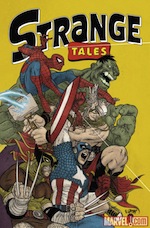 Strange Tales II #1 (of 3)
Strange Tales II #1 (of 3)
Writing and Art by Rafael Grampa, Kate Beaton, Jeffrey D. Brown, Nicholas Gurewitch, Kevin Huizenga, Jeffrey Lemire, Frank Santoro, Dash Shaw, Jillian Tamaki, Johonen Vasquez, Shannon Wheeler, Gene Luen Yang, Rafael Alexandra Claudino Dias
(Marvel Comics)
Pull: Yes. Because this was a great idea and needs to be tried more often.
Chris says: Strange Tales are what you get when you ask top indie and webcomic creators for their take on Marvel characters, although most of the better stories in this anthology tend to be the straightforward ones.
This book is one crazy mix of tones, starting off with Rafael Grampa’s (Mesmo Delivery, Furry Water) blood-soaked tale of Wolverine in a mutant wrestling league and his…particular…relationship with pain. The tale is explicit and gruesome but ends up being very touching. Wolverine is one sad, sad self-healer. Frank Santoro (Storeyville, Cold Heat) plays it similarly straight with a slightly expressionistic tale of the Silver Surfer. Dash Shaw (Body World, The Unclothed Man in the 35th Century) starts out the same way with his Spider-Man/Mysterio tale, although he allows Spider-Man to get very self-reflective when confronted with Mysterio’s tricks: ”I could stay here forever! Drifting! Lost! I love the illusion!“
There is more, much more, than that in the issue. Nicholas Gurewitch (Perry Bible Fellowship) and Kate Beaton (Hark! A Vagrant!) provide some short, funny takes on Magneto and Kraven, respectively, and Gene Yang (American Born Chinese, Prime Baby) puts together a tale of someone who can’t help fighting crime, no matter what he does.
If I say anything about anyone else I will end up spoiling the whole issue for you. It’s a lot of fun and a concept definitely worth supporting.
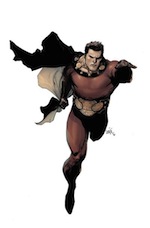 Superior #1
Superior #1
Written by Mark Millar
Art by Leinil Francis Yu
(Marvel Comics)
Pull: On the strength of the names attached to it alone, yes; I can’t imagine passing up a book by Mark Millar and Leinil Yu.
Matt says: Mark Millar drops his newest addition to “Millarworld” this week, with a book you could think of as “Big-meets-Shazam!” Instead of waking up as Tom Hanks, our “Billy Batson” (in Superior he’s MS-stricken teen, Simon Pooni) wakes up as “Superior,” a Superman clone right down to his “boy scout” rep and offworld origin story. If crossing a Penny Marshall rom-com with an action comic sounds strange, you may begin to understand the somewhat disorienting feel to issue #1; the 22 pages are spent on exposition, and we yet have very little sense of what Superior is really going to be “about.” Is this a light-hearted bildungsroman? A dark tale about children forced to grow up to fast? A parable about great power and great responsibility? So far, it’s too early to tell.
Millar seems to have a knack for getting average art out of stellar artists; I had commented in my review of Nemesis on Steve McNiven’s lackluster performance, and Superior provides a similar disappointment from one of my longtime favorites, Leinil Francis Yu. Much like McNiven, Yu at his worst is better than most artists at their best. But alas, having been spoiled by Yu’s delivery on titles like High Roads, Superman: Birthright, and Secret Invasion, I’m afraid that Superior often fails to live up to the same sky-high standards. That said, Yu’s storytelling is always sharp, he never skimps on backgrounds, and the characters are consistent and recognizable throughout the book. I’d love to see the next couple of issues show off Yu’s talent a bit; in the meantime, we’ll just have to overlook a couple of weird perspective shots and muddy shadows…
In the end, Superior fails to impress right out of the gate the way previous Millarworld titles have; instead of the adolescent glee of Kick-Ass or the destructive indulgence of Nemesis, the first issue of Superior simply delivers a couple of heartwarming characters and a bunch of promise for great things to come. If this issue came from an unknown writer, in fact, I’d say that we’ve seen it all a thousand times before. The fact that it’s Millar means that I’m intrigued enough to stick around—but I certainly hope this isn’t a sign that Millar is starting to rest on his laurels (really impressive, considerable laurels as they may be).
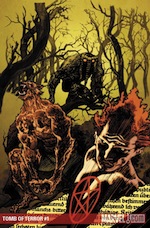 Tomb of Terror #1
Tomb of Terror #1
Written by Paul Hornschemeier, Joe R. Lansdale, Joseph Thomas Pruett, Rob Williams
Art by Travel Foreman, Jordan Raskin, Mark Texeira
(Marvel Comics)
Pull: Yes! Refreshingly, resoundingly YES.
Annie says: This comic saved my Wednesday. There is nothing like paying $4 for one comic that contains four different (and unbelievably good) stories. There is a strong theme that links through all of them of control versus no control. Fortunately for the reader (but unfortunately for “innocent” bystanders), the side sans control usually proves to be victorious and this does more than keep the stories engaging, it keeps them worth reading.
”Man-Thing – Descent of the Beast“
GUYS. This train-of-thought-written comic was absolutely captivating. I didn’t know anything about Man-Thing before this and yet now I have absolutely no questions about where he comes from, what he does, and what his morals are. You see the inner struggle between a man fighting what he is (a combination between Swamp Thing, Predator, and the Abominable Snow Man) and what he formerly was (a good guy). The stream of consciousness that the text is written envelopes the reader in what is going through this thing’s head, how his life has changed, and how unsuccessful he is in controlling what he has become. The artwork is gorgeous; done entirely in black and white. Part of me wishes the artwork was done in color so that I could get a better look at exactly what the creature is but the shadowing and the lack of detail put this character into the realm of things that could jump out and get you, which, I think, is the ultimate kind of scary.
”Son of Satan – Silence“
This story begins with a pretty original premise; one of NASA’s bastard projects went terribly wrong a long time ago. It ended with the disappearance of Commander Delano and the brutal demise of two of his fellow astronauts. The story was kept very hushed and life seemed to move on as if it never happened. Cut to present day New Mexico, when some guy with a leather jacket and a pentagram on his bare chest, Daimon Hellstrom (the Son of Satan) shows up in a trailer home yard to speak with the long-lost Commander’s son, Erik. Even though Erik lives a life of solitude, he seems to recognize the Daimon and invites him into his home. Once both men are seated, Erik explains that he knows why the man has come to see him and that they are one in the same; they both are given instructions via their fathers do to absolutely horrific things to other people. Erik admits that he’s just “following his father’s instructions” and that even though no one else can hear his father, he’s doing the right thing. Daimon questions this, and regardless of the fact that he’s Satan’s Son, he calls the police instead of taking the matter into his own hands. In this story, control was victorious over the lack thereof. This story had a nice little twist, which definitely made it worth paying attention to.
”Werewolf by Night – The Cure“
Another prime example of control versus no control. In this story a man who has learned to control his ability to transform into a werewolf finds himself in the middle of the woods where there’s an apparent surge in lycanthropy. He knows that by killing another werewolf, he will be cured and return to normal. He has the chance to kill one but hesitates and the opportunity passes. Without giving away too much more of the story, his hesitation or, to keep congruent with the ongoing theme, his lack of control over the situation, is the major wrench in his plan. The story for this comic was really good but the shadowing and grainy nature of the artwork made it sort of hard to follow, or at least get a good look at how many other werewolves were involved and the quality of the fight scenes. Incredibly well written but could have been lightened up a bit.
”The Living Mummy – The Heist”
This story was formatted more like an illustrated story than an actual comic. No panels, three illustrations and about two pages worth of text. This story actually felt more like a fable than a comic. Three thieves break into a museum all Shawshank Redemption style (i.e. through the sewers) to steal an African mummy for someone willing to pay major dollars. There’s a catch, though. (There always is.) The mummy they’ve been asked to steal could come alive at any moment, according to ancient legend, and if it does it will be overtaken by madness. Well, guess what? The mummy comes alive and it wasn’t until I finished reading this story that I figured out why Marvel slapped a parental advisory claim on the cover of this comic. Pretty awesome graphic details as to what the mummy ends up doing to these thieves. Moral of the story? Don’t steal, and certainly don’t steal mummys.
 Victorian Undead Special
Victorian Undead Special
Written by Ian Edginton
Art by Horacio Domingues, Ethan Van Sciver
(DC Comics / Wildstorm)
Pull: No, absolutely not.
Annie says: Halfway through this comic, I felt like I had already read and reviewed this story.
Sherlock Holmes has just survived a zombie uprising in London circa 1899. Things are beginning to return to normal until a 10 year old girl is mauled, mysteriously, and her father is arrested for trying to cash a check made out to him from Dr. Jekyll. Sherlock Holmes and his sidekick, Dr. Watson, go about solving this crime only to find out, dun dun dun, Dr. Jekyll and Mr. Hyde are responsible. This story has been told so many times that just by reading the title you’ll know what’s going to happen. Unfortunately, for those of you who might’ve not read anything about Jekyll/Hyde in your travels, this isn’t one I would recommend anyway.
The cover art is gorgeous; capturing the duality between Dr. Jekyll and Mr. Hyde perfectly. I had hopes that the black and white artwork would carry throughout the rest of the comic as well but to no avail. The artwork is good but, in the end, nothing spectacular.
When Matt Lampert isn’t writing about comics, he’s a philosophy professor in New York City.
Annie Gala is inundated in October.
Chris Greenland got four out of five pulls this week and is going to Vegas with that kind of luck.










